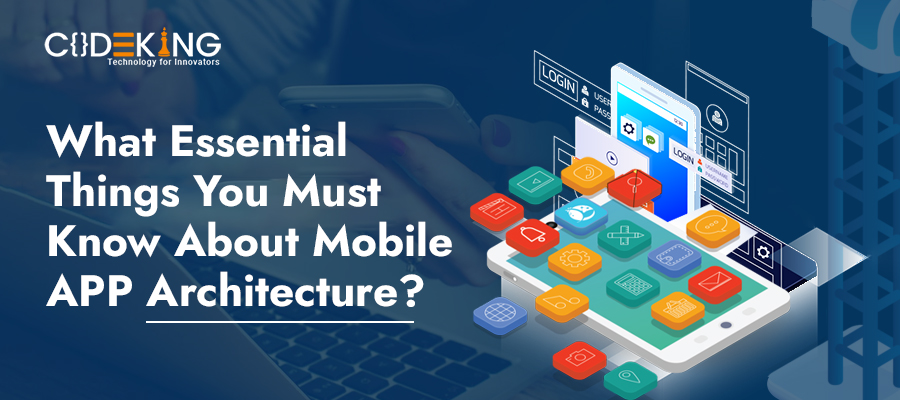For a successful mobile application, a robust architecture is essential for its structure and functionality. To assure stability, performance, and quality, the developers of these apps use a variety of architectural patterns, but choosing the best one is very crucial.
Therefore, today’s blog will provide a thorough exploration of mobile app architecture, including types, best practices, and design factors. As the potential of this industry is enormous, as seen by the 80% increase in mobile app downloads globally between 2016 and 2022, companies now spend money on Mobile App Development Services to increase engagement, speed service access, and improve customer contact.
What Exactly the Architecture of Smartphone Applications is?
Developing a phone application’s architecture is the first and most important phase in its building process. It serves as the framework, or skeleton, around which the careful development and design of the app are built. To ensure perfect execution of all these things, let’s move further.
It might be not encouraged by many, but the magic of an app’s architecture is what brings everything together and creates a smooth user experience. The rules governing how components and the application are connected are established by it.
An app framework for smartphones can be defined simply as the model or design and building approaches combined to create an ecosystem of mobile applications. It serves as a guide for Android apps, which will be developed in accordance with the architecture.
Why Does an Excellent Framework of Apps for Phones Matter So Much?
The success of your mobile application depends heavily on its architecture, which is a critical component and should not be overlooked at any cost. A sound framework for these applications has great significance for the following reasons:
- Quality and Speed– The underlying architecture has a significant impact on the quickness and excellence of your Android app. Undoubtedly, this configuration establishes how various parts work together and behave to provide functionality for the entire application. App’s architecture serves as the framework that gives it form and structure. Consumers detest slow and sluggish applications and prefer those that operate smoothly and intuitively. As an efficient framework responds quickly to human input, the user experience is improved. Thus, to produce an impressive phone app, you must pay attention to the architectural design and adhere to the best practices for its development.
- Compatibility– Selecting the appropriate framework is necessary if you want your application for mobiles to work on a variety of smartphone platforms and devices. The various architectures of various phone applications provide varying degrees of system. When these apps are compatible, it means that they may share and receive data from other systems and carry out their intended functions without facing interface limitations. You may create a system that interacts with other ones and offers essential interoperability with a strong framework.
- Adaptability and Scalability – It would be very challenging and complex to add new functionality to an application that you have developed without a clear architectural pattern. Incorporating additional features into your software without compromising its overall quality will be extremely impossible for you. Therefore, the design of your Android app is needed to make it scalable and adaptable so that it can readily take on new requirements. It makes it simple to add new features and alter them to suit your needs when its framework is clearly defined. Furthermore, as you expand, your application can support a higher volume of users and work without compromising its dependability or performance. It is increasingly vital for you to have an app that can grow with its user base.
What are the Crucial Components for Developing a Mobile Application Architecture
For your software, you must design a solid framework that will endure over time. Its creation necessitates taking into account the following several variables:
- Understand the Device’s Needs
You must think about the device and hardware characteristics you want to target while creating a robust architecture of the app for your phone. Determining the target devices’ resolution, screen size, memory, storage, and other features in addition to the tools and development environment would be also necessary. However, it is important to obtain information about the device that the program will run on because it depends on the hardware and its features to work.
- Manage Variations in the Network
Your application for smartphones will experience periods during its lifetime when the internet connection is spotty or completely unavailable. But, no matter what, your program should be prepared to handle the worst possible network conditions. Creating an app framework that can manage any network connection condition is really vital.
- Interface User
It is impossible to overestimate the significance of UI and UX, which should be created to maintain users’ engagement and offer a flawless experience. For designing an application that appeals to your target user base, you should incorporate these two elements into their architecture diagram.
- Push Alerts
Consider whether your users need notifications or real-time updates when formulating the information framework of your Android app. Push notifications are visually appealing, but they can cost a lot and use up battery life and bandwidth on phones. The process of developing these applications involves several steps that encompass different layers and technologies. Moreover, each step of that process involves different topics, such as backend logic and user interface design. The various layers that make up the architecture of applications for mobiles stack together to form the entire app ecosystem. In addition, there are many advantages to layering the design, like maintenance, scalability, flexibility, and reusability. So, invest in Solid Mobility solutions to upscale your business and bring the best development team on board.
Read More: https://www.blog.codekingsolutions.com/best-guide-for-application-development/
Which Various Layers of the Framework for Smartphone App Development Are There?
An Android application’s architecture consists of numerous levels that exchange information and communicate with one another to initiate different activities. The majority of these apps share the following common layers:
- The layer of presentation – The presentation layer specifies how an application will be shown to users at the top of their framework’s stack. The audience interacts with these apps through their user interface and communication layer. It provides end users with presentation services that gather and show user data. These user experiences of the mobile applications form the presentation level. In simple words, this is the layer that manages user interactions and serves as an interface’s front end for them, displaying a variety of GUI elements. The appropriate client type must be chosen by the developers of these apps for it to work with its architecture. However, developers must select a fitting data format and employ strong data validation techniques.
- Business Layer – This layer has to do with the application’s business logic. It offers a collection of guidelines and formulas for controlling data flow throughout an enterprise. For this reason, the business level specifies how information for a phone app will be created, handled, saved, and utilized. The main responsibilities of this level are exception management, security, data validation, logging, and data caching. The layer of business of an application for a smartphone may be on a server or a device, depending on how it functions.
- Layer of Data – A reliable and efficient system for data exchanges is required for every Android app. The data layer, which guarantees smooth transport and receiving of information, is in charge of this duty. To facilitate data transactions within an application, this layer is made up of many components such as data utilities, service agents, and information access components. These app developers must think about maintenance and simplicity of modification while developing this level to accommodate changing requirements.
What are Some Real-Life Examples of Android Application Architecture?
The framework of mobile apps differs depending on the user type and platform. For instance, a manifest file declares all the components that make up an application for smartphones, such as fragments, activities, content providers, and services. On the other hand, app data is packed and compressed for iOS applications, which are located in the Bundle directory or IPA container. Some of the other different modern architectures for these apps are:
- Android Mobile App
Native applications are phone apps created specifically for Android smartphones. They are created especially for an operating system, such as Android. Concerning such devices, there are numerous manufacturers. Thus, these applications must utilize the Java and Kotlin languages and adhere to certain specifications. Hence, developing these apps for mobile cannot be done with a single framework.
Nonetheless, the Clean design remains the most widely used Android architecture in business smartphone application development. Layers and the idea of inverted code are the foundation of the Clean architecture. It is made up of layers for data, business, and presentation, and each of them communicates with the others through interfaces and is autonomous.
Benefits of clean architecture include:
- Simple troubleshooting and testing.
- UI is divided.
- Not reliant on outside frameworks, databases, or libraries.2. Ios Mobile App
Objective-C and Swift are the two programming languages used to create native iOS applications. Apple guides creating apps with an MVC design, however, there are no explicit rules for Android applications. It’s the most popular design for developing phone apps, even though iOS developers are free to use any architecture.
Smartphone applications use a three-tier architecture called MVC. The various levels it possesses are as follows:
- Model: Made up of model objects, parsers, networking code, and other components, this layer controls the data, rules, and logic of an app.
- View: In the MVC framework, it is the presentation layer and has user interaction components, but no business logic is present.
- Controller: The layer of the controller facilitates communication between the other two layers, Model and View.
MVC architecture offers advantages such as:
- Quicker procedure for developing applications.
- Unambiguous communication between many layers
- Simple and easy-to-maintain app architecture
3. Hybrid Architecture for Mobile Apps
These applications for phones combine web and native programming. Web content is loaded into the native app shell of these applications. Web technologies like HTML, CSS, and JavaScript are utilized to create them. They have access to a mobile app’s hardware functionalities. Single codebases are used by the hybrid application for smartphones across several mobile platforms. Thus, a single such app will work on both iOS and Android devices.
Benefits of a hybrid application interface include:
- A single codebase across several platforms
- Cost-effective and cross-functional
- Access hardware features
4. App Interface for Cross-Platforms
Cross-platform applications are another popular architecture for developing mobile apps. Similar to hybrid ones, they are compatible with both iOS and Android and have the same codebase for multiple platforms. But, they are built on frameworks.
Numerous frameworks and technologies exist for developing cross-platform applications, including Flutter, Ionic, Xamarin, React Native, and others. These apps perform better than hybrid applications and provide an experience that is much more similar to native ones.
The advantages of cross-platform applications are:
- One codebase to support several platforms
- Native app-like quality and performance.
- Obtaining hardware features and quicker loading times.
Which Features of the Framework of a Phone Application are Vital for Driving Results?
For a mobile application to be stable and reliable, its architecture must be adaptable, expandable, customizable, and have other attributes. These are some important qualities of a flawlessly planned and developed framework for an app.
- Returnability – Developers can create and implement application features more quickly when there is code reuse. It is taken into consideration while designing an effective mobile app architecture, which enables professionals to create and publish updates and versions of the applications quickly.
- Durability – The environment of an app for a phone is subject to unpredictable changes. For example, modifications in market demand or advancements in technology. So, your application must be prepared to adapt to these changes. It demands an Android app framework that can withstand these modifications. A sustainable application for smartphones can adapt to new developments, such as enhanced servers and technology.
- Performance- When it comes to app creation, Mobile App Development Company gives priority to functionality and user experience. Users anticipate that applications and this applies to both Android and iOS should perform actions and react to taps instantaneously. Thus, pick an architecture that provides outstanding performance.
- Adaptability – Over time, you’ll need to include new functionality due to changes in consumer needs. If the framework of your app is adaptable, adding new characteristics will be simple, otherwise, the process will be difficult. That’s why breaking out the components of the software to create a loosely connected architecture will make feature integration easier.
- Ability to Scale- A framework for your application must allow for easy scalability in order to handle an increase in users and app load.
- Safety- These days, security is so important that major corporations are spending millions to strengthen security. Examine an app architecture that guarantees compliance with several standards and offers a high degree of safety.
- Test-ability – Your application framework will be more dependable if it has a high testability rating because there is a lower likelihood of bugs. Early in the development process, it is simple to find and address mistakes or bugs because of a tested architecture, which results in a well-functioning and adaptable end product.
- Sensitivity- In addition to making your software scalable and versatile, you should prioritize the user experience by providing an intuitive and user-friendly interface for your program.
What are the Best Practices for Android App Architecture?
Every crucial component of your mobile application, including scalability and performance, depends on its framework. As a result, it’s critical to select the one that best suits your needs and provides a top-notch user experience. Apart from this, it will also help you avoid future reworks, which will save you money and valuable time.
By following these effective practices, you may begin with a strong architectural diagram for a smartphone app:
- Select a framework that divides the data layer from the user interface. It will make changing easier and provide reusable code.
- Adhere to appropriate software engineering concepts and practices. When designing the architecture and creating the application, adhere to concepts like KISS, SOLID, etc. Moreover, you can use lightweight, straightforward data formats like JSON for APIs.
- Keep abreast of the latest introductions in mobile app development to ensure your product meets the demands of today’s users.
How to Choose the Finest Framework for Your Mobile App?
Knowing how important architecture is for all apps for phones, you need to consider the advantages and disadvantages of several designs before selecting the optimal one. You may select a suitable architectural design for these applications by keeping the following tips in mind:
- If money is not an issue for you, you ought to think about creating native apps. Its performance and user-friendly operation are only two of its numerous benefits.
- If users of iOS and Android make up part of your target audience, then choose a native application or make a cross-platform app that will cater to users on several platforms.
- To assist promote your brand across a wider range of devices, you might select a hybrid solution. But, a variety of architectural patterns, each with unique benefits and downsides, are used in the development of mobile apps. An application’s interface, which determines its stability and performance, is its foundation. However, the choice of architecture can be affected by many factors, including the app type, tech stack, development timeline, and business needs. To select the best one for your phone application, you must evaluate several of them.
WRAPPING UP!
The tech stack and app architecture that you choose for your phone application are impacted by scalability, performance, and security. When deciding on features and app structure, take user stories and business needs into account. Remember that project failure can occur when features like security and scalability are neglected. But, collaborating with dependable technology can help close skill gaps and produce cutting-edge smartphone apps.
Therefore contact codeking today, to get exceptionally developed mobile applications with an impressive and solid framework and interface. An impeccable Android application for your business with extreme performance and functionality is a guarantee of ours.
FAQs
Why is the architecture of mobile apps important and what are its essential components?
For a smartphone application to be stable, performant, and of high quality, its interface is vital. It ascertains how different components function in concert to provide a smooth user experience. Some of the vital elements of its architecture are understanding device requirements, controlling network variances, creating user interfaces, and putting push alerts into practice.
What are the best methods for creating the framework of an Android app and how to choose the right one for your application?
The best practices for building mobile app architecture include following software engineering concepts such as SOLID, keeping up with the newest development trends, and isolating the data layer from the user interface. However, when deciding between native, hybrid, or cross-platform frameworks, take into account variables including target audience, budget, and platform compatibility.
Why hire a mobile app development company to secure an excellent developed smartphone application?
Collaborating with a reputable Android Application service provider can facilitate the filling of skill gaps, guarantee state-of-the-art development methodologies, and provide superior phone apps with remarkable functionality and performance.




